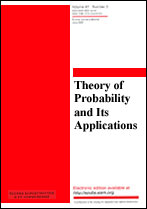|
Short Communications
Probability characteristics of downfalls of Brownian motion with drift
S. N. Lobanov
Steklov Mathematical Institute, Russian Academy of Sciences
Abstract:
This work studies the distribution of maximum downfall and downfall from maximum for Brownian motion with drift. Contrary to the usual measures of risk, these statistics do not use the value of process at time 0 as a reference point for measuring losses. Instead, these downfalls choose two points inside the interval. In particular maximum downfall chooses two consecutive moments to maximize the difference between the process values in these two points. The downfall from maximum uses the point of absolute maximum as an initial point and the consecutive local minimum as the final point. The main result of this work is the Laplace transform with respect to the length of the interval for the cumulative distribution function of downfalls. The Laplace transform turns out to be in this case more convenient for analytical work than explicit formulae. The distribution function is known only for the maximum downfall. It is expressed as an infinite sum with coefficients which are consecutive solutions of the equation which cannot be solved analytically. The inversion of the Laplace transform is not computationally more difficult than evaluation of the infinite sum which represents the explicit cumulative distribution function of the maximum downfall.
Keywords:
downfalls of Brownian motion.
Received: 16.02.2005
Citation:
S. N. Lobanov, “Probability characteristics of downfalls of Brownian motion with drift”, Teor. Veroyatnost. i Primenen., 50:3 (2005), 570–579; Theory Probab. Appl., 50:3 (2006), 489–497
Linking options:
https://www.mathnet.ru/eng/tvp97https://doi.org/10.4213/tvp97 https://www.mathnet.ru/eng/tvp/v50/i3/p570
|


| Statistics & downloads: |
| Abstract page: | 482 | | Full-text PDF : | 188 | | References: | 99 |
|




 Contact us:
Contact us: Terms of Use
Terms of Use
 Registration to the website
Registration to the website Logotypes
Logotypes








 Citation in format
Citation in format 